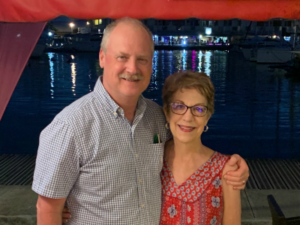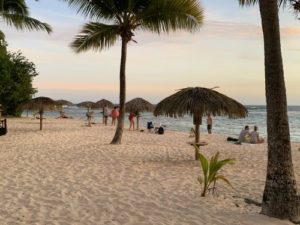By Emily Clott, Class of 2012
Photographs by the author

I’m writing on a cold, cloudy March day. Snow is in the air, everything fun is canceled, and I’m wondering, as Trevor Noah asks each night on his Daily Show: “Is this how we die?” It’s early in probably 8 weeks or so that we’ll endure before the Covid-19 pandemic eases, but already I find myself sinking into the Slough of Despond.
But NO, this is not an acceptable response to this punch in the gut—I have my memories! My husband Chris and I traveled on Christmas day to Guadeloupe (pronounced gwad-uh-loop), an idyllic tropical paradise in the Lesser Antilles, about 500 miles north of Caracas, Venezuela and 400 miles north of Trinidad and Tobago.
Why Guadeloupe? After watching a couple of episodes of the BBC mystery series “Death in Paradise,” we learned the program was set in Guadeloupe. “That’s a French overseas territory!” I told my husband. “We should go!” Since he has a nice pause in the academic year, we tend to get out of town the week between Christmas and New Year’s. This was a great choice, as January might turn out to be the high point of 2020.
There being no direct flight to Guadeloupe, we flew to Miami, through Port au Prince, Haiti, and finally to Pointe à Pitre, Guadeloupe’s capital. As an Overseas Territory of France, Guadeloupe is basically France wrapped in a tropical paradise. The official language is French, the currency is the euro, and residents are French citizens. Most visitors come from mainland France, so English is not widely spoken. Speaking French was almost essential to book through VRBO and to rent a car.
Cruise ships do not dock on the coast, so there are no hordes of tourists near the ports. We stayed in a studio apartment about 50 steps from the Caribbean, surrounded by swaying palms, tropical birdsong, and oh, yes, fresh croissants from the restaurant a hundred yards away.
This trip was not about architecture. The island was formed by a volcano and is buffeted by frequent hurricanes, so buildings are low and sturdy. The economy is agricultural, with sugar, rum, and bananas the main export products. Snorkeling, hiking, and exploring the many miles of nature preserve are among the activities enjoyed by tourists. Chris and I mostly hung out at the beach, read books, and took it easy. In the evenings, we drove to nearby towns of St. François and Ste. Anne to dine and browse the shops.
 The pace was relaxed, the islanders were friendly, the food and wine were delicious. At the beach, we noticed that all the women, no matter what age, shape, or size wore bikinis—some only the bottom half at that—how French! I felt so out of place in my modest American swimsuit that I bought myself a 2 piece suit at the earliest opportunity for two reasons: first, nobody was looking at me, and secondly, why worry so much, even if somebody is? We Americans could take a lesson from the French attitude that all bodies are good, and because of that, we should give ourselves a big hug and say “Yay body! Thanks for being such a good package for me!”
The pace was relaxed, the islanders were friendly, the food and wine were delicious. At the beach, we noticed that all the women, no matter what age, shape, or size wore bikinis—some only the bottom half at that—how French! I felt so out of place in my modest American swimsuit that I bought myself a 2 piece suit at the earliest opportunity for two reasons: first, nobody was looking at me, and secondly, why worry so much, even if somebody is? We Americans could take a lesson from the French attitude that all bodies are good, and because of that, we should give ourselves a big hug and say “Yay body! Thanks for being such a good package for me!”
On New Year’s Eve, we took an all-day excursion in an off-road 4X4 with three French tourists and our guide, Micah. We traveled through banana and sugar cane plantations, toured a rum distillery, and hiked up a rocky escarpment in a National Preserve to a volcanic hot spring where we enjoyed a hot-tub like experience in the middle of the jungle. Did you know that the bananas we eat are the pistils of the banana flower? I sure didn’t.
 We also learned that the vivid plaids known as madras seen all over the market stalls of the island are due to the influence of the East Indian culture. When the Europeans arrived and started cultivating sugar cane, they worked the native population to near extinction, then imported slave labor from Africa. After the Haitian slave revolt led France to abolish slavery in 1804, the French colonists imported laborers from their enclave in Pondicherry, India. Our guide informed us that the population of Guadeloupe today is roughly one-third French origin, one-third African origin, and one-third Indian origin, a true melting pot.
We also learned that the vivid plaids known as madras seen all over the market stalls of the island are due to the influence of the East Indian culture. When the Europeans arrived and started cultivating sugar cane, they worked the native population to near extinction, then imported slave labor from Africa. After the Haitian slave revolt led France to abolish slavery in 1804, the French colonists imported laborers from their enclave in Pondicherry, India. Our guide informed us that the population of Guadeloupe today is roughly one-third French origin, one-third African origin, and one-third Indian origin, a true melting pot.
We left paradise to return to winter, relaxed and rejuvenated, with memories of sunshine, blue skies, warm days, and sea breezes to bring back a smile any time we need one. I have a feeling that will be pretty often in the months ahead!




Emily, I’m JEALOUS !! But so glad you got this vacation in before the lockdown. Now…..save us from the suspense: did you go topless too ????? JK! Just like on a tour, You do NOT have to answer EVERY question!! Thanks for an uplifting article for us all —
What a wonderful memory to keep you going through the, yes, 8 weeks or more it will be stay at home. Thanks for a wonderful story, and I would certainly think of going there soon, too. What a way, too, to spend the Christmas holidays! Greqt.
Wow. I could feel the breezes and taste the food. Wonderful description. I’m a big fan of death in paradise so I know exactly how it looks, thanks
Emily, thanks for sharing such a lovely trip. I visited Guadeloupe long ago (in the early 1970s) and remember the wonderful food: French with hints of the Caribbean, including some unforgettable piri-piri pepper sauce. Also breakfast toast/croissants with piri-piri peanut butter. And the taste of incredibly rich espresso coffees.
I enjoyed your descriptions of Guadeloupe. We traveled there about 40 years ago and it looks and sounds the same, We also watch the BBC show Death in Paradise but was hoping the charming island hadn’t chanced much; thanks for the update!
As the world flipped and is still fighting to survive, your island trip sounds surreal. So happy that you and Chris have those wonderful memories… Next step is French films. Felicitations!